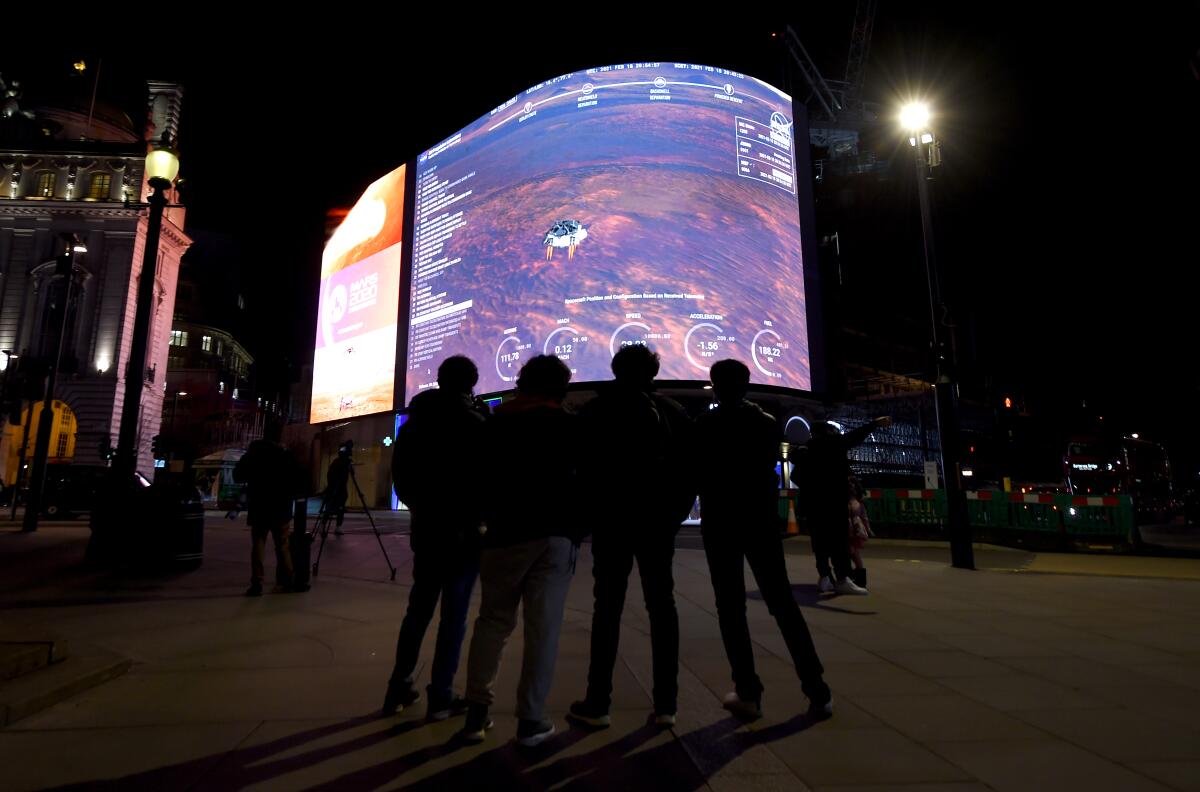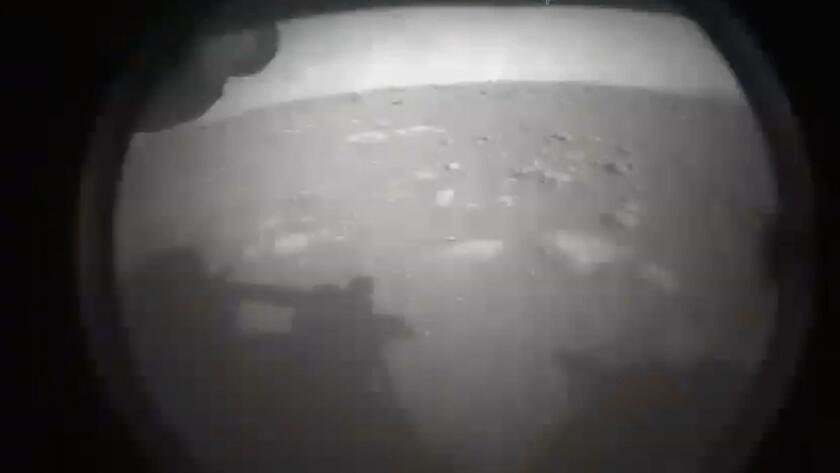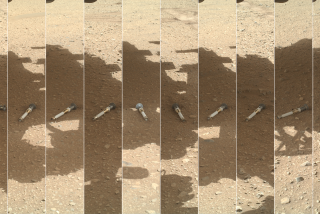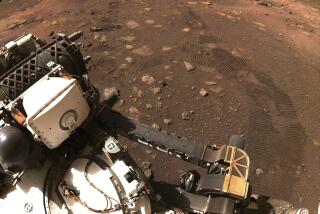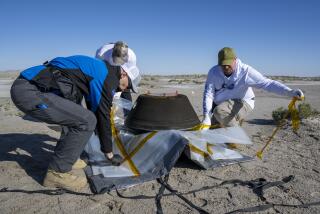NASA’s Perseverance rover makes safe landing on Mars
- Share via
- Share via
NASA’s newest rover touched down safely on the surface of Mars on Thursday, completing a 293-million-mile journey through space and setting the stage for a mission that seeks to find evidence of ancient extraterrestrial life.
The six wheels of the 2,260-pound Perseverance rover landed in Jezero Crater, a former lake bed once fed by flowing water that scientists say would have been a welcoming home for microbes in Mars’ warmer, wetter past. If they’re right, the remains of those long-dead microbes should now reside in the sediments there.
Ecstatic team members in Mission Control at the Jet Propulsion Laboratory in La Cañada Flintridge could not hug or high-five one another, as they normally would in non-pandemic times. But even their doubled-up masks — whose top layer was adorned with a stylized image of the rover — couldn’t hide the smiles on their faces as they clapped and cheered, a few feet apart.
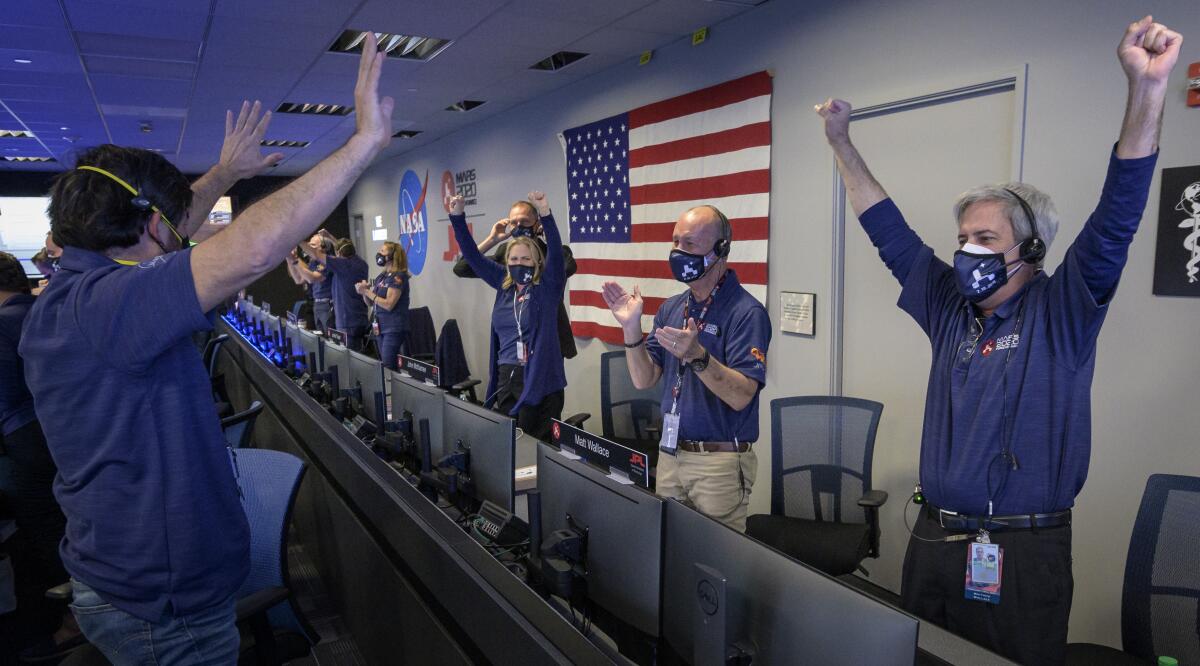
Some bumped fists with those around them while others shook them triumphantly in the air after mission officials confirmed the rover’s landing at 12:55 p.m.
“NASA works,” said Rob Manning, JPL’s chief engineer and a veteran of many Mars missions. “When we put our arms together and our hands together and our brains together, we can succeed. This is what NASA does. This is what we can do as a country on all of the problems we have. We need to work together to do these kinds of things and make success happen.”
Acting NASA Administrator Steve Jurczyk said he got a call from President Biden about an hour after landing to send his regards to “Percy” and his compliments to the team.
Within moments of reaching its new home, Perseverance transmitted two images of the surrounding Martian terrain.
“You can see the shadow of the vehicle and you can look out into the horizon, and that is just a great thing to see,” said Matt Wallace, deputy project manager for the overall Mars 2020 mission.
Perseverance, the star of Mars 2020, survived a hair-raising arrival procedure that’s often referred to as the “seven minutes of terror.”
This final stage of the 6½-month journey involved a dramatic deceleration from a speed of more than 12,000 miles per hour at the top of the Martian atmosphere to a mere 1.7 mph when it was just above the surface.
The carefully choreographed routine required a heat shield, a supersonic parachute, retrorockets and the “skycrane” maneuver, which involved lowering the rover from midair on a set of roughly 21-foot-long tethers.
If NASA’s Perseverance rover lands safely on Mars, it will become the first space mission in nearly 45 years to directly search for signs of microbial life.
Shortly before reaching the top of the atmosphere, the spacecraft used thrusters to bring its spin of two rotations per minute down to zero. “From here on out it’s just going to be a bullet,” Manning said.
Another pivotal moment in the landing sequence came when Perseverance successfully deployed its parachute. “Yes! Yes!” team members could be heard exclaiming upon confirmation that the rover had successfully slowed down.
Sticking a landing in Jezero Crater was long considered unthinkable, since the site is strewn with sharp rocks and boulders, treacherous sand dunes and hazardous cliffs. But JPL engineers made this possible by equipping Perseverance with new technologies that gave the rover the autonomy to avoid hazards on its own, said Allen Chen, leader of the entry, descent and landing team.
With under-the-hood upgrades such as Range Trigger and Terrain-Relative Navigation, Perseverance was able “to avoid all that death that’s out there for us” and guide itself to a nice flat spot with a mere 1.2-degree tilt, Chen said. “We found a parking lot and hit it.”
Jennifer Trosper, deputy project manager for Mars 2020, said the surface operations team was thrilled to have made it to the planet.
“Our job is to think of all the bad things that can happen and try to avoid those — and when all good things happen you feel like you’re dreaming,” Trosper said. “I’m happy to feel like I’m dreaming today.”
Arriving safely at Mars was just the first hurdle of the $2.4-billion Mars 2020 mission, which will last for at least one Martian year (about 687 days on Earth).
“Now that we’re on the ground, now the fun really starts,” said Lori Glaze, director of NASA’s planetary science division.
The science team is already hard at work examining the rover’s pictures and figuring out what to tackle first. Glaze said she’s eager to see the imaging and microphone data gathered by the rover during its descent. For the first time, “we’re all going to get to experience just exactly what that was like,” she said.
Perseverance has a lot on its to-do list.
It’s tasked with using its suite of sophisticated cameras and specialized instruments to search for so-called biosignatures — materials, textures and other telltale patterns in ancient rock that could be signs of past life.
The rover’s job will be to select a promising and diverse set of samples, which it will collect and stow on the surface for future spacecraft to retrieve and ferry back to scientists waiting on Earth.
NASA and the European Space Agency have a complex plan to collect samples of Martian rock and soil and send them to Earth. Here’s how it will work.
Jezero Crater is an ideal spot for this work, geologists say. It features a delta — a clear sign that running water once flowed into a body of water like a lake. That would have been an ideal environment for trapping any microbial life that may have existed billions of years ago.
Caltech geochemist Ken Farley, Mars 2020’s project scientist, said the rover landed about 1¼ miles southeast of the delta, along the boundary between two geologic units. Perseverance came to rest on a smooth area known as the mafic floor unit, which adjoins a rough area full of sand dunes called the olivine-bearing unit.
“This is a great place to be because one of the things that scientists love to do is look to see how two different geologic units come together,” Farley said. “It tells you a lot about the geologic history.”
Within weeks, Perseverance should be ready to deploy Ingenuity, a 4-pound, solar-powered helicopter that would be the first of its kind to fly on another world. If successful, it could pave the way for future flying planetary explorers.
Roving around Mars is so passe. So NASA is sending a helicopter to the red planet.
The rover will also use an onboard instrument suite to synthesize oxygen using the carbon dioxide in the thin Martian atmosphere. The proof-of-concept experiment could show that it’s possible on Mars to create both breathable oxygen and spacecraft fuel — two essential resources for any humans who may one day visit the red planet.
It will be several weeks before Perseverance embarks on its science mission. Until then, its handlers will be checking the rover, downloading new flight software for surface operations, and perhaps doing a few calisthenics — that is, stretching out to see if its robotic arm is moving as it should.
Over the coming weeks and months, Perseverance will transmit gorgeous Martian panoramas, detailed color images and new scientific findings. But there’s no beating the magic of the first days on another world, JPL Director Michael Watkins said.
“There is something special about the first few days, because we have just landed a representative of the planet Earth on a place on Mars that no one has ever been to,” he said.
